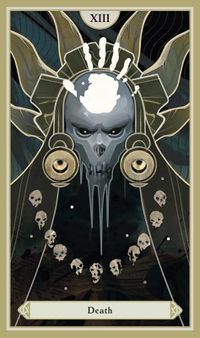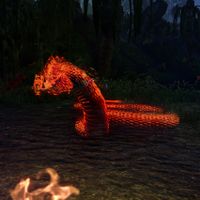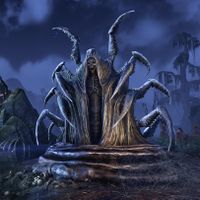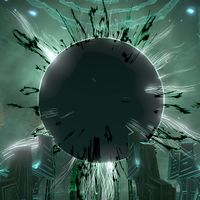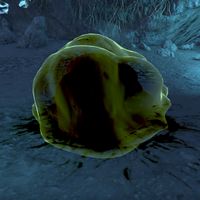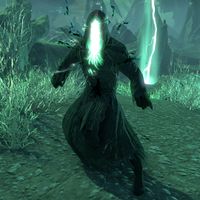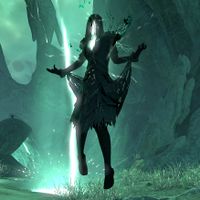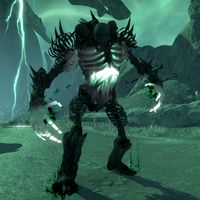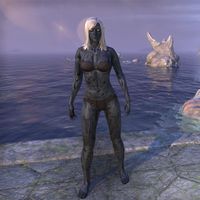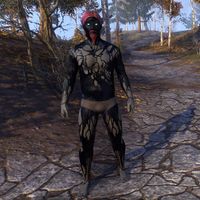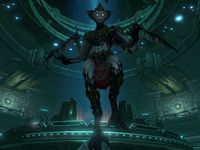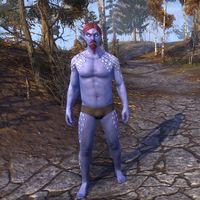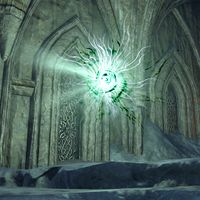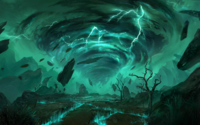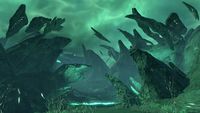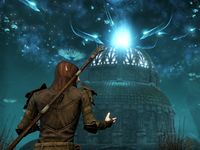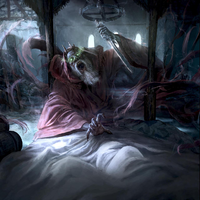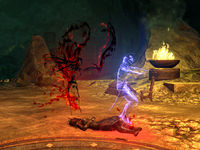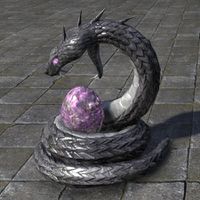Lore:Void
| The Void | |
|---|---|
| Type | Unknown |
| Realm | Aurbis |
—Lady Belain
The Void (also called the Outer Darkness,[1][2] the Ancient Darkness,[3] the Great Darkness,[4][5] and Lorkh-Apeiron)[6] is the name applied to the dimensions between and beyond the known realms of the Aurbis: Aetherius, Oblivion, and Mundus.[7][8][9] The term "void" is also occasionally used in a more limited capacity to refer directly to Oblivion.[10][11] Legends say that deities wishing to create a new plane of existence must initially create a space for it in the Void.[12] It is described as a place of endless night or endless nothingness, with very few things living in it.[1] The spirit of Lucien Lachance claimed that the Void is a cold place, one with no pain.[13]
Contents
Cultural Views[edit]
—Vateshran Eoinola
Sithis/Padomay[edit]
According to the Anuad and one of the Monomyth's accounts, the brothers Anu and Padomay came from the Void.[7][14]
Argonians equate the Void to Sithis, a blank canvas and a creator that will one day destroy its creation so that it might create something new, the "nothing between the something" and the Void from which all arose and to which all will one day return.[15] The ancient Kothringi and Argonians were theorized to have worked together on a religious depiction symbolizing Sithis and his interplay with the primordial origin in the form of an enchanted statue. The statue depicted a dark serpent poised to strike at a polished azure gemstone, the primordial origin which was metaphorically represented as an egg.[16] The creation myth of the Adzi-Kostleel tribe equates nothingness with the serpent Kota, who fought the Great Root Atak at the beginning of time until the two became one and shed their Shadow. The myth ends with the Shadow of Atakota devouring creation and settling over it as a shroud of darkness to protect it from destruction.[17]
The Dunmer believe that Sithis is the true start of creation, of Aurbis. It is said that before Sithis emerged there was only nothing. This nothing was the stasis of Anu, which is said to be foolish to name or revere, since "stasis asks only for itself, which is nothing", as also mentioned in the Sermons of Vivec. It was Sithis who disrupted the stillness and fashioned the myriad of possibilities that make up existence from it, creating new ideas that arose, ebbed and flowed, and faded away in an endless cycle.[18] The Clockwork Apostles of Sotha Sil claim that Padomay and the padomaic Daedra are illusions who only exist and have influence due to the flawed design of Nirn, the result of the Void taking root within the cracks of the Aedra's work.[19] According to Vivec, Stasis and Change, Anu and Padomay, are infinite forces and realms residing in the infinite Void, the latter infinity paradoxically enclosing the others in a manner akin to an encircling sphere. At the intersection of the two forces, where they touch, lies a "perfect circle of pattern and possibility", the Wheel, and inside that Wheel lies the Aurbis which is its foundation. Vivec claims that outside the Wheel exists the Void, which cannot truly be named and is bereft of anything. The Void is said to have more aspects than just Stasis and Change, but they cannot be named as they are outside of true language.[UOL 1]
One pre-ri'Datta Khajiit account regarding the Middle-Dawn depicts the ongoing interplay of Anu and Padomay as two warring serpents surrounded by twelve flaming spinning wheels. One a serpent of flaming feathers and crystal scales with a head like a hunting bird, and another a crimson eyed serpent of blackest scales and a white mane followed by all the Void. The flame-feathered serpent is said to emanate rejection of all "Mannish impurity in all the known worlds". The dark serpent, though surrounded by chaos, is said to emanate gentleness and love for the spirits of the worlds. The interaction of Boethra with these two warring serpents is said to have ended the Dragon Break, an event known as the Division of Heaven.[20]
According to the Dark Brotherhood, when Sithis wishes someone killed, their soul comes to the Void after death.[21] One of their faithful servants, Lucien Lachance, was known to have gone to the Void after death. His spirit claimed to feel disturbances in the Void when the Dread Father was displeased.[13]
The Wrath of Sithis is a wraith-like being believed to act as a conduit for Sithis' wrath. According to old stories circulated among members of the Dark Brotherhood, the being will hunt down any who betray the organization and drag their souls to the Void. In 2E 582 the Wrath appeared to take the soul of Lyra Viria, the Black Dragon, who had betrayed the Brotherhood. That same year, a Brotherhood tome that was bound in black leather and detailed a series of grisly rituals, including the "Rite of Penance" which served to summon forth something more dangerous than even the Brotherhood's assassins, was discovered.[22][23][24][25] In 2E 582, the Vestige encountered an aspect of Sithis which took the form of a spectral red serpent. This being recognized the "void" of the absence of a soul within the Vestige, deeming it intriguing. It described trying to name or understand it as futile, like trying to hold chaos in one's hand.[26]
Namira[edit]
The Khajiit equate the Void and Namiira, calling it the"Great Darkness", with their creation story affirming that only after Lorkhaj's birth in the Great Darkness did it know that its name was Namiira. Namiira, the Great Darkness, is described as a spirit of infinite realms, which only Azurah knows in their entirety. Dro-m'Athra are the spirits of Khajiit which heeded the beating of the Dark Heart and were transformed, taken to the Dark Behind the World to serve Namiira.[27][4][5]
Reachmen regard Namira as the Spirit Queen, avatar of all primal dualisms, and the sovereign of one of the two worlds of existence, the infinite world of spirit which is the source of all fundamental competing forces.[28] The Reachfolk creation story speaks of Lorkh having an epiphany when he visited the darkness, that "nothing does not exist", where some perceive nothingness exists "possibility", the canvas on which "all that is can be".[29] And so, Lorkh approached Namira and convinced her to grant him a place in the infinite void to create a realm for wayward spirits, but it was not without a cost. Lorkh sacrificed himself to create a harsh realm, one that is unforgiving and intended to teach through suffering. In the caverns beneath Lost Valley Redoubt there is a place known as the Dark Descent, where the realms of flesh and spirit are said to intersect.[30][31]
The Dark Heart is said to be a piece of primal void that "warps the weave of existence" around it.[32]The Prophecy of the Dark Heart describes how at the end of days, the Dark Heart will awaken once more, and darkness will spread from it to consume all, spreading only Namira's faithful. It is said that the slumbering Dark Heart can only be awoken by death, by feeding on souls, and so death is the "greatest gift" a mortal can give to Namira. It is said that, once the Dark Heart is fully awoken, the Void will surge from it, rising from the deep places, and covering the world. Those who embrace the darkness, however, will be spared, as there is power in it for those who believe and hold true to its word.[31]
Other Beliefs[edit]
Azurah's realm of Moonshadow is described as a world formed of the moonlight tears she shed after the death of her mother Fadomai, and it is said the darkness pulls away from its waters. Within the realm lies the Void Gate, which is said to open into an unending expanse of cold and dark water that ripples whenever the spirits within it, ones that are "one with the darkness", move. Azurah is send to send the spirits of her champions within this darkness, armed with her Moonlight Blade, to bring her lost children home.[33][34]. In Khajiit belief the Noctra is believed to be a Dark Spirit born of the black blood which spewed from the Dark Heart of the wounded Lorkhaj, it is said that, though she might aid the Khajiit when called, Noctra should not be summoned to aid with "vile deeds" as that will "bring the Dark with her".[5] According to one pre-ri'Datta Khajiit account, during a battle to defend the Lunar Lattice, Noctra used the Skeleton Key on herself in order to stop Merid-Nunda from accessing the Aether Prism, this caused her form to become as "shadow and cloth, a cloak of darkness" and "grow mighty, taller than the rest" of the deities present, until it went on to blend with the night itself, shrouding the Aether Prism and foiling Merid-Nunda's attempt.[35] According to another pre-ri'Datta myth, Y'ffer, the "Elden King of Graht", is said to have eventually been corrupted by the Great Darkness, having "drank of the dark and became something more". After this occured, Y'ffer is said to have struck Nirni, killing her. Hircine, Khenarthi and Azurah are said to have fought and slain him in retaliation, subsequently crafting a cairn for Nirni out of his bones.[36][6]
The Star Orphan Xero-Lyg is described as a "Black Star" that once fought alongside Lorkh within "alternate worlds" and "unto endless possibilities". She is associated with the element of Flesh and is said to wander alongside the Unstars of the Serpent constellation, themselves described as a "hungry void", as a force "so dark as to not be at all". Thus this spirit might have some connection to Namira, who myths also associate with the Missing God and the Void.[6]
Some sources describe Hermaeus Mora as being "the void and the ever-seeing eyes" who "resides everywhere and nowhere".[37]:585 The energies and essences of both Hermaeus Mora and Namira are said to take the form of "roiling darkness", and are so similar to one another that additional decorative elements are required to determine which of the two an artifact belongs to. This strong similarity has caused some scholars to theorize that the two Daedric Princes share a close relationship and are linked to one another in some manner.[38]
Characteristics[edit]

—Opius Balvel, Oblivion Walker
The Void is described as an infinite expanse of "endless night" or "endless nothingness" which exists between and beyond the planes of the Aurbis,[39][1][7][9] the "place outside the places" and the "darkness beyond Mundus and Oblivion",[8] it is said that no corporeal life can reside within the dark expanse, and no incorporeal life can witness it and return unscathed, with the Daedra themselves being unwilling to discuss its nature.[40]. The "blessedly few" forms of life which naturally live within the Void are thus described as "strange beyond imagining".[1] Some sources describe the Void as the source of an unending decay which gnaws at the world.[41] Coming into direct contact with the "nothingness between realities", even momentarily, can prove fatal, and requires being "anchored to reality" through powerful magic such as that of a Daedric Prince to survive.[42] One individual who was in the process of experiencing this phenomenon described it as being "unmade", his body was unraveled, but his spirit ultimately made it to Aetherius.[43]
Though elusive, some descriptions of the conditions in the Void do exist. The spirit of Lucien Lachance claimed that the Void is a cold place, one with no pain.[13] The witch Arana, whose soul was temporarily consumed and taken into the Void by the Dark Heart, likewise described an experience of being dragged under by a dark, icy current. She described a suffocating feeling, with every moment spent in the darkness being "an eternity" and the period of time the experience truly lasted being impossible to determine.[31] The substance of the Void has been described as the "waters of the Ancient Darkness" with "waves of Void" being said to "wash through" those that traverse it.[3]
Though sometimes described as "nothingness", the Void emanates its own form of essence and energies. This "voidstuff", originating from "between places" is known to change life it comes into contact with, twisting the very souls of beings it touches into "hungry, hateful shadows" called Shades.[44][8] In some cases the being that came into contact with Void energies is not transformed outright, their soul having managed to find purchase in another plane once more after drifting through the Void. However such souls are still subject to and feel the "relentless pull" of the Void, gradually manifesting sings of its "vast emptiness" on their bodies in the form of a sheen of void-essence, until their soul is finally pulled from their bodies and into the Void once more, a condition known as "Void Pathosis".[45] Shades themselves have described their existence as dominated by a feeling of emptiness.[46] Those afflicted by the Void to the point of having become "void husks" are said to feel an all consuming desire to externalize the nothingness within them, consume all that is not them and make it nothing as well, doing so is said to provide momentary relief from the gnawing inside them.[47] Even for those who can traverse the Void, it is said that the nothingness seeps into them should they tread it for too long, "mangling" them and "twisting" them into something "other" than what they were. The bodies of such individuals are known to exhibit physical changes due to this phenomenon.[3]
The contact of the Void with Khajiit souls in particular is held to be responsible for the formation of Dro-m'Athra, a process described as the result of the Void seeping into cracks which are created in the soul when one hears the beat of the Dark Heart,[48] such cracks which can invite the Void are also said to form when one feels an emotion so strong it fills the spirit so completely as to make it crack.[49] Dro-m'Athra are dark spirits who have been described as "bizzare mutants" of a Daedric nature by the Daedra themselves. It is said by master necromancers that to view Dro-m'Athra as either just a form of Daedra or as just corrupted mortal souls is not quite accurate.[50][51] Khajiit Twilight Cantors have described the Dro-m'Athra as the "shadowed face" of the Khajiit which echoes the light and dark facets of the moons, a form the Khajiit takes after succumbing to the Dark Heart's call, which the Khajiit can naturally hear, due to rage and anguish.[52] The Bent Dance calls to the spirits of the Khajiit even in death, and spirits which have not yet reached Azurah's Crossing can still hear and be lured by it.[53] Certain types of animals such as Durzogs that ended up in Blackreach are said to have heard the call of the Dark Heart and come into contact with Void energies, causing them to become drenched in the Void's corruption and be transformed by it. Such creatures are described as having a chilling presence.[54]
It is possible to chart the Void or journey into it through the use tonal, aetheric and kinetic energies and a medium such as the Dark Heart. The Dwemer are known to have constructed a great orrery at Arkthzand, powered by the energies of the Dark Heart, for this purpose. Though it is possible to reach specific destinations within the Void such as Grayhaven in this manner, the process is dangerous, as the chaotic energies of the Void can warp the portal, flinging those attempting the journey into the emptiness itself.[55]
Mages can sense the presence of the Void, describing the feeling it invokes as being akin to a great weight being pressed down on one's chest.[31] There are places on Nirn like Deepmire where it is said one might "fall into the Void".[56]
The Psijic Order had the means to scry secrets from fate lines beyond the bounds of Tamriel. Among these secrets were tomes that spoke of alternative timelines and realities, where certain key events transpired differently.[57] One of those tomes spoke of a reality where the Order detected a group of unknown entities who had been pushing through the Void to reach Nirn for centuries. The Order sought aid to ascertain the nature of these beings, they prayed to the gods of Elsweyr that they were Dro-m'Athra, sought the Dark Brotherhood hoping they were the spawn of Sithis, and made sacrifices to the Gray Host thinking they might originate from Grayhaven, but in all cases the approaching beings proved unrelated and the Order found no answers. With no other option the Order gathered and formed endless nets of Sacred Numbers out of threads of purest Magicka, hoping to repel the invading horrors. The entities were unlike any beast, Daedra or spirit the Order had ever seen. The smaller creatures were tangled in the net and fell back into the Void, but the largest gazed through the breach with a single great unlidded eye. Those who gazed upon the eye could not unsee and were unmade by the sight alone. Though the Order struggled until there was nothing left, the net eventually failed and the veil ripped asunder to allow the entities into the world, causing everything to be unmade by their arrival.[58]
-
A Minotaur Void spirit
Uses[edit]
Pockets of Void essence produce shardlike material formed of the concentrated energies. Both void pockets and void shards are said to have a "heaviness" to them, akin to a force pulling surrounding objects into itself, the fragments seek to rejoin the energies they emerged from and thus approaching a void energy pocket with a shard in hand allows for instant transportation, pulling the holder through the pocket and into a new location, though "walking between the shadows" in this manner runs the risk of transforming into a Shade. Shades have also been observed using this method of transportation.[59][60]
Despite the dangers the Void poses, there have been cases where its energies have been tapped into for power. At times Reachman clans and witches have been known to tap into voidstuff for their magic, producing powerful void liches known as Voidmothers and bringing about great calamity for the whole of the Reach.[61][44] The energies of the Void have also been used by vampires of the Nighthollow Clan as a form of sustenance, removing their need to consume blood but replacing it with a need to keep taking in void energy, which ultimately resulted in the clan becoming "diminished" and feral when the flow ceased.[8] In 2E 582 the Dark Heart was used to attune the Gray Host to the Void, making it so their souls partly resided there. The connection allowed them to access the Void and its energies and sense the passage of souls through it, but they risked consumption by the void energies without proper control.[55]
The fully awoken Dark Heart is described as a source of limitless power, in 2E 582 the Gray Host partly awoke it in an attempt to sever their souls from their contract with Molag Bal and attain immortality not unlike that of the Daedra within the realm of Grayhaven which existed beyond the reach of the Daedric Prince The means through which this goal would have been achieved was the Darkstorm, a more potent form of Harrowstorm formed of the Dark Heart's void energies which would have absorbed all souls in the Reach to fuel the magic.[55]
In 2E 582, Xulneihavu Shuxaltsei, a vampire priestess of Sithis during the Duskfall, attempted to carry out a ritual meant to make the great serpent, Sithis, stir and return all creation to the Void. Shuxaltsei's ritual was interrupted by the Vestige and the priestess herself was slain.[62] In that same year, Verandis Ravenwatch utilized the Gray Host's link to the Dark Heart against Rada al-Saran, pulling his spirit from his body to aid the Vestige in battling him, and subsequently to halt the Darkstorm ritual after the battle was won. This event caused Verandis to fall into the darkness of the slumbering Heart, where he was transformed, his soul itself becoming "smelted inextricably" to the fabric of the Dark Heart's existence. In his altered state, Verandis was able to draw the souls of Markarth which the Dark Heart had absorbed and dragged to the Void back to Nirn, restoring them to life.[55][31]
It is said that assassins, who often use the shadows to cloak their movements, may sometimes discover hidden pathways through the deeper darkness of the void, allowing them to magically transport themselves across great distances.[63]
Scourge, an artifact created by the Daedric Prince Malacath is known to employ the powers of the Void. The legendary mace was created for use by mortals against Daedra and was cursed by its creator so that, should any Daedric being attempt to invoke its power, a "voidhole" will open up and swallow them, banishing them to the Void.[64]
Necromancers of the Order of the Hidden Moon are said to have been able to call to the Void in order to invite a willing soul to inhabit a physical form and aid them in battle.[48]
Notable Places[edit]
- Grayhaven
- A lost realm of Oblivion located deep in the Void, said to exist in neither Mundus nor Oblivion but between, it is described as beyond the reach of the Daedric Princes.
- Slipstream Realm
- The realm of the Battlespire, located at the edge of the Void and several realms of Oblivion.
Gallery[edit]
Notes[edit]
- The Daedric Princes are known as the "Princes of Void", though they are more accurately denizens of the "Void of Oblivion".[10]
- Allegedly, many smaller voids (created in the likeness of the void beyond Aurbis) came together to form Oblivion. [UOL 1]
- The "Eight Abysses",[65] and the "Nineteen Voids" are unknown terms which may be related to this dimension.[66]
See Also[edit]
References[edit]
- ^ a b c d Hollowsoul Steed mount description in ESO
- ^ Wonshala Keriayn's dialogue in Battlespire
- ^ a b c Ethertide description in ESO
- ^ a b Words of Clan Mother Ahnissi — Clan Mother Ahnissi
- ^ a b c The Dark Spirits — Amun-dro, the Silent Priest
- ^ a b c The Nine Coruscations — Star-Queen Varalias
- ^ a b c The Monomyth
- ^ a b c d Gwendis' dialogue in ESO: Markarth
- ^ a b Lucilla Caprenia's dialogue in ESO
- ^ a b Pocket Guide to the Empire, 3rd Edition: Arena Supermundus: The Tapestry of Heaven — Imperial Geographical Society, 3E 432
- ^ The Book of Daedra
- ^ Varieties of Faith... — Brother Mikhael Karkuxor of the Imperial College
- ^ a b c Spectral Assassin's dialogue in Skyrim
- ^ The Annotated Anuad
- ^ Nisswo Uaxal's dialogue in ESO: Murkmire
- ^ Nest of Shadows' description in ESO
- ^ Children of the Root — Solis Aduro
- ^ Sithis
- ^ The Truth in Sequence — Deldrise Morvayn, Fourth Tourbillon to the Mainspring Ever-Wound
- ^ The Bladesongs of Boethra, Volume V — Modun-Ra, the Hidden Voice
- ^ Ocheeva's dialogue during Permanent Retirement in Oblivion
- ^ The Five Tenets
- ^ Wrath of Sithis in ESO: Dark Brotherhood
- ^ Green-Venom-Tongue's dialogue in ESO
- ^ Book of Dark Rite's description in ESO
- ^ Aspect of Sithis' dialogue in ESO
- ^ Litter-Mates of Darkness — Moon-Bishop Hunal
- ^ Great Spirits of the Reach: Volume 3 — Vashu gra-Morga, Chief Daedrotheologist at the University of Gwylim
- ^ The Dark Descent loading screen in ESO: Markarth
- ^ Great Spirits of the Reach: Volume 5 — Vashu gra-Morga, Chief Daedrotheologist at the University of Gwylim
- ^ a b c d e Arana's dialogue in ESO
- ^ Count Verandis Ravenwatch's dialogue in ESO: Markarth
- ^ The Favored Daughter of Fadomai — Amun-dro, the Silent Priest
- ^ Azurah's Crossing — Amun-dro, the Silent Priest
- ^ The Bladesongs of Boethra, Volume III — Modun-Ra, the Hidden Voice
- ^ The Worldly Spirits — Amun-dro, the Silent Priest
- ^ The Elder Scrolls V: Skyrim Legendary Prima Official Game Guide
- ^ Trifold Mirror of Alternatives description in ESO
- ^ The Dark Descent's loading screen in ESO: Markarth
- ^ On the Nature of Oblivion — Cananmildil, Leading Scholar of Daedrology
- ^ Lady Belain's dialogue in ESO: Markarth
- ^ Mephala's dialogue in ESO
- ^ Leythen's dialogue in ESO
- ^ a b Rites Matron's dialogue in ESO
- ^ Void Pathosis description in ESO
- ^ Maebroogha the Void Lich' dialogue in ESO: Markarth
- ^ Hollow Void Husk description in ESO
- ^ a b Zerith-var's dialogue in ESO
- ^ Viti's Notes: Order of the Hidden Moon, Part II — High Cantor Viti
- ^ Vastarie's dialogue in ESO
- ^ Loremaster's Archive - Mehrunes Dagon & Daedra in the Second Era — Lyranth
- ^ High Cantor Viti's dialogue in ESO
- ^ Eifa's dialogue in ESO
- ^ Voideater Durzog description in ESO
- ^ a b c d Verandis Ravenwatch's dialogue in ESO: Markarth
- ^ Jaxsik-Orrn's dialogue in ESO
- ^ Tracker of Temporal Tomes achievement description in ESO
- ^ Garden of Sacred Numbers Temporal Tome
- ^ Pentarch Cievernes' dialogue in ESO: Markarth
- ^ Void Portals — Pentarch Cievernes
- ^ Gwenyfe's dialogue on Voidmother Elgroalif related quests in ESO
- ^ Nisswo Xode's dialogue during She Who Eats the Light in ESO
- ^ Recall of the Outer Darkness description in ESO
- ^ The Requisite Book of Daedra
- ^ The Unveiled Azadiyeh Answers Your Questions — The Unveiled Azadiyeh
- ^ Interview With Two Denizens of the Shivering Isles — Haskill and Dyus
Note: The following references are considered to be unofficial sources. They are included to round off this article and may not be authoritative or conclusive.
- ^ a b The Thief Goes to Cyrodiil — Vivec
|
||||||||||||||
|
|||||||||||
